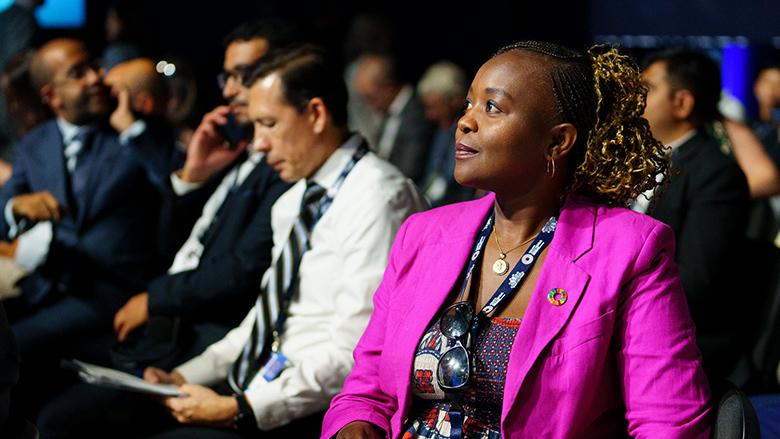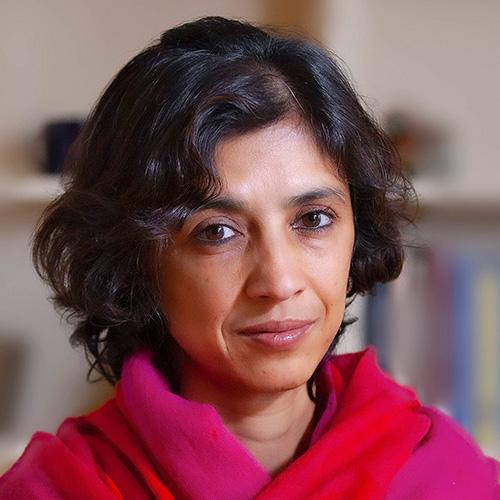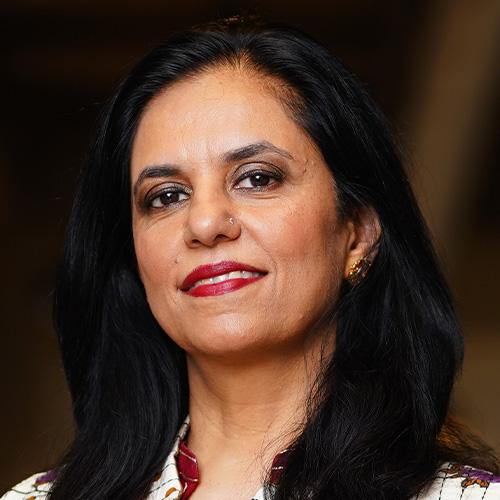[Subina Shrestha] Good morning, afternoon, and evening. Greetings to everyone joining from wherever you are, including World Bank Live, Facebook, and X. I'm Subina Shrestha, your moderator for today. Welcome to this event, where for the next hour, we shall explore South Asia's most obvious untapped potential: women. The World Bank recently unveiled South Asia Development Update, which focused on women, jobs, and growth. What jumped out for me was, should as many women enter the workforce as men, South Asia's per capita income could increase by 50%, and South Asia is already the fastest growing amongst emerging markets and developing economies. What is needed for two-thirds of South Asia's working-age women to join the labor force? Is being more open to global trade one of the answers? Will global investment boost women's employment? Come join this discussion. You can interact through #SouthAsiaDevelopment and post questions online through World Bank Live’s chat window. To answer all your questions, we have a stellar cast of panelists. But before I introduce you to everyone, we have a special treat for you, a chat with Martin Raiser, World Bank Vice President for South Asia, in conversation with Rohini Pande, Director of Economic Growth Center at Yale University. Over to you, Martin.
[Martin Raiser] Thank you very much, Subina, and I hope that I hope everybody can hear me well. I'm extremely happy to be with Professor Rohini Pande, who is the Henry Heinz II Professor of Economics and the Director of the Economic Growth Center at Yale. Rohini, among many other things, you've been a leading voice for inclusion economics. In fact, I think you are a Faculty Director of a department or a unit called Inclusion Economics at Yale. And hence I could think of no better person to talk about one of the two topics of our South Asia economic or development update, which is the potential that the region would have from including more women into the active labor force. This is against the background, as Subina has mentioned, that South Asia has indeed been the fastest-growing region in the world, but it could do even better. What we want to look at, in this particular conversation, is how we judge, how we estimate the impact that increasing women's labor force participation could have on economic growth. We use a variety of models, and the estimates range between a 13 % to 51% increase in South Asia's output if women's labor force participation were raised to that of men. Yet some in the region argue that given the value of women's domestic work, the existing division of labor within the household is in fact optimal. There may be very few true economic gains or welfare gains from raising female labor to force participation. Professor Pande, what is your view on this perspective?
[Rohini Pande] Let me start by thanking you and Subina for inviting me to join. It's great to be here, and I greatly enjoy reading the World Bank Report. I also congratulate everyone who contributed to it. I think you did an excellent job of laying out the issues and also drawing on the literature. First, as background, let me just agree with the fact that I think it's important we recognize that unpaid work is work, and women do a lot of the work in the care economy, and anything we talk about in terms of bringing them into the paid work stream should not take away from the fact that all women work all the time. I think rather than starting by asking the question about economic gains, I'd like to pose it, maybe perhaps a little bit more, also as a question of rights. I think a very reasonable place to start with is: what do women want? Rather than thinking abstractly about what do people say, I think it's very reasonable to ask: do women want to work? If they do, and if they're citizens of countries, I think governments have a responsibility to ensure that they have the opportunities they can choose from. It's fantastic that on top of it, economic gains will follow. But I think it's important to start with evidence on what do women themselves want. I think a lot of surveys across here typically show that South Asian women want to work. Just to give you an example from India, in 2011 and 2012, which was a point of a very significant decline in work by women, according to the Indian National Sample Survey, and that's the last time that question was asked, more than 30% of women engaged primarily in domestic activities who were thus counted outside the labor force have stated that they like to work. And if all these women who stated that they would want to work did actually take up work, we would see a rise of 21 percentage points, of 78% in the female labor force participation. I think there's a strong argument, irrespective of GDP, that we just want to give women the jobs they want. There is, of course, on top of it, the issue that we know that education rates have been rising very fast among women in South Asia. Other than tertiary education, we have largely closed the gaps. It's extremely likely that there is increasing talent misallocation by keeping women out of the labor force. I think that's the second argument, which is the growth argument for why we do that. I think the one factor that we need to be careful about is that a rise in GDP doesn't mean that everyone is better off. If markets have any element of labor market power, if there is monopsony, there may well be powerful labor market insiders who will actually see their rents decline as women join the labor force. I think in some ways, it's not this absolute puzzle of women want to work, GDP will rise. Why don't we just open the doors for work? But rather, I think any policy interventions needs to be sensitive to the fact that there will be some set of people who will lose out potentially. Thinking about how one addresses that is going to be also critical.
[Martin Raiser] Actually, that's a really important point. Now, if we think about the factors, I mean, this is obviously distributional implications, insiders that may resist it. Maybe one of the reasons why it's been more difficult to raise female labor force participation in the region. But in the Report, we identify a number of other factors, including, for instance, questions around safety of transport, around physical mobility. You mentioned the legal framework at the beginning of your intervention. Childcare, but also social norms that may lead to discrimination or may lead to women for reasons of compliance with social norms, preferring to stay at home, even if they would rather take up employment. If you look through the various factors that I just mentioned, which one do you think is the binding constraint? If you had to prioritize interventions, policy interventions, if your goal was to try and enable women to fulfill their wishes and achieve the economic gains that would come with it, where would you start?
[Rohini Pande] I think a key feature in thinking about how do you address the issue of female labor force participation, which I think is different from thinking about questions of, for instance, how do you give appropriate employment opportunities to the world's extreme poor, is that here the lack of employment is because of gender, not income, and it's actually occurring within a household where the male member or the son, who arguably has access to the same household income, is doing much better. I think it's important to keep that upfront, because we often talk about barriers in this very abstract sense, physical safety. Well, you could argue, you could flip that around and say, the question is, how do you actually get men on streets to behave better? The reason I state that is I think we have some amount of evidence that some of the issues or some of the ways the barriers are described tend to reflect quite a lot of paternalistic discrimination. We have a young researcher, Nina Buchmann, who has a paper from Bangladesh showing that managers tend to internalize what they believe is the cost of physical safety to women and don't offer them jobs. Even the women themselves are perfectly capable of figuring out ways of getting to work and getting back. I think for that reason, I would say it's less about thinking about a binding constraint. It's rather trying to think about how do you just give them an opportunity and how do you actually not limit them. I think the moment we start putting these abstract notions of things like physical safety, it tends to raise the specter that it's alright to not employ a woman if you can't guarantee physical safety. Actually, it's not. Everyone has a right to work. Men and women, they should make the choice about what they see as physical safety. Of course, government states and others should be responsive for physical safety, but it's not our role as policymakers to make that a justification for offering employment or not. Let me say, putting it differently, I think the binding constraint should be seen less in terms of this one constraint that needs to be removed, but rather we should ask who benefits from the existing binding constraint and how do we change their incentives? I think a lot of what we are seeing, a lot of what we saw during the pandemic, and as we know in South Asia and other countries, in the recovery, women have had a harder time to recover than men. This is very much in contrast to what, say, happened in rich countries, is that when jobs become scarce, it's very easy to invoke many of these reasons for justifying what's going on. I think it's important for us to challenge a little bit the frameworks as well.
[Martin Raiser] Right. Now, just following up on this, some of what you were saying to me suggests that you think the problems are more on the demand side. So women are willing to work, but employers are not even considering offering them jobs. And then they use justifications like safety and others to get that. But how about the possibility that women themselves may not want to seek employment because they're afraid for their own safety, or their husbands may be afraid for their own safety? If that's the case, you have a social norm, it's often hard to... What we find is that people, when responding to questions about social norms, sometimes their own sense of them is much less strong than what they think other people believe, but they think it would be inappropriate. So how do you go about changing that? How do you create empowerment? I think some of your own work looks at distribution of power within the household. You look at financial empowerment of women, financial inclusion of women as one of the factors that might give them the encouragement to pursue what they would like to do. But tell us a little bit more about, in this complex environment, what could policy interventions look like that address this web of issues?
[Rohini Pande] Thanks for asking the question. I think it's useful to step back to realize how extreme, how low female labor force participation is in poor households. This idea that women choose to not step out because they are concerned about safety seems harder to justify in a world where you don't have enough money for food. I think the striking feature of thinking about this, and I think the reason to push back a little bit against this narrative that this is their own decision, is the fact that these are incredibly poor households. I think according to the World Bank's own estimates, for every 100 men in extreme poverty in South Asia, 110 women are. The choices are very stark here. You're thinking about physical safety against something else. Having said that, I completely agree with you that it seems to be that in all the surveys we see, women and men state that the community stigma that they believe men face, not women, when women work, is one important reason for this. Some people think of it in terms of even social status, you want to move up in the status by having household members who don't work. I think it's an incredibly important role for the state to do things like, for instance, affirmative action and quotas. For instance, in most settings, rural and urban, government jobs are quite well respected and quite open to women, unlike, say, private sector jobs. We've had experiences that when school teacher positions have had affirmative action for women, that's both been good for getting girls education, but has also opened up labor market opportunities. I think, thinking as the World Bank, one example I give, the World Bank does a huge amount of procurement in different countries through its loans. It does infrastructure. We have from the US very good examples of how federal minority contractor diversity requirements have led to an increase in, say, black contractors in the US. I think just starting with the Bank or multilaterals that are doing a huge amount of infrastructure lending, and to think about how they build into it at every level, at the level of who gets the contracts to who are the workers', I think that will be a huge way of signaling. One way to break these social norms is for the state or other players to signal that they don't see a stigma here.
[Martin Raiser] Right. Actually, I'm not sure we're all the way there where you would like us to be. But we do, in every one of our projects, we do look at the implications that it would have for increasing gender equality. One of the problems is that we don't often have the metrics to track this all the way through implementation. We think through the modality. But there are some really good, positive examples. I recall, for example, a network of women in the energy sector, recognizing that there are very few women in engineering jobs and a network that the World Bank helped to support called WePOWER, that regularly brought together female engineers working in power distribution companies and transmission companies and generation companies. Just the sheer fact of them getting together was encouraging others and was serving as a bit of a role model. It's a small example, but it's… [Rohini Pande] You can do harder things. [Martin Raiser] Yes. [Rohini Pande] I think the Bank itself in the DC office and other places has done it. It has its own great examples of how, with its own personnel, it's done it. I think trying to think of ways of supporting this in low-income countries would be fantastic. [Martin Raiser] Yeah. I take the challenge. I think we're certainly moving in that direction when you look at the way that these things are being considered in project design. I think where we need to make more systematic follow-up is to look at what then happens during implementation. But perhaps a final question for you, Professor Panday. How much of this in South Asia is a reflection of the broader phenomenon that it seems rapid economic growth has not gone hand in hand with the same dynamic of job creation. I mean, put differently, could you imagine that if labor demand as a whole were growing more rapidly, and can you see when you compare different parts of the region with each other, that that would also benefit women more? Or do you think we really need to look at affirmative action, as you put it, as the main route towards creating more female employment opportunities?
[Rohini Pande] I think, of course, if there are more jobs, some people will benefit. But in a setting where right now in most South Asian countries, the demographic divide is really showing up in, say, 15 to 30-year-olds, it's not clear where the job creation is going to put any women in front of the line. My colleague, Penny Goldberg and Gaurav Chiplunkar, have a very nice recent paper, actually based in India, showing that one of the best ways of jobs getting created by women is to have women entrepreneurs, women hire women. We've seen evidence of this across several countries. Job creation isn't a monolith. Someone is creating the jobs. Who they choose to create the jobs for and how, I think, seems to depend very much on things like, in this particular case, gender. In some ways, I think of it as a cheat. I think to say it's about increasing job creation is to avoid the question, which is really you can go a very long way without feeling a need to give women jobs unless you either see the gains you get from having women or you're responding to some legislation.
[Martin Raiser] Thank you very much. I think we ran out of time. We could have gone on for a long time. But thank you, Professor Panday. Thank you so much. I take away a few key points before passing back to Subina. The first is start by asking women what they actually want rather than assuming that you know. Second, empower women, for example, by supporting female-headed enterprises, but also through things like procurement policies, to create those opportunities. And then hope that the example spreads and that that may also, over time, reduce some of the constraints, the multiple constraints, including from social norms that we talked about. But thank you very much. I enjoyed the conversation and much more to talk about. But back to you, Subina. Thank you.
[Subina Shrestha] Thank you, Martin, and thank you, Professor Panday. I really enjoyed it. The thing that I took away from it was clearly, change is not a straight line, and there's always going to be resistance to change, and much needs to be done, including a shift in the value of women's work, including unpaid work, and a significant change in gender attitudes that allows women to enter the workforce and stay in the workforce. Now, moving to the panel discussion that you've all been waiting for. We have with us Deepak Mishra, Director of Indian Council for Research on International Economic Relations, Roshaneh Zafar, President of Kashf Foundation in Pakistan, and Franziska Ohnsorge, World Bank Chief Economist for South Asia. My first question goes to Franziska. The South Asia development update that you've been working with and been living with almost for a while, what are the most exciting prospects with regards to growth and what are the risks?
[Franziska Ohnsorge] Thank you, Subina. It's a pleasure to be here. The South Asia is the bright spot in the global economy. It is the fastest growing, it remains the fastest growing emerging market and developing economy region. We had expected that six months ago, but it turns out it's even better than we had anticipated. And not just in one or two countries, it's truly broad-based. And this is also not just all consumption, it's really broad-based, this upside surprise. And you can sense this excitement also when people talk about South Asia, for example, when you talk to the media, when you talk to think tanks, there's a sense that South Asia is humming along and is growing faster than everyone else. It's really the driver of emerging market and developing economy growth. Now, you ask what worries me. The region is very close, we get back to that. We look at three risks in particular, and they're all domestic. So one, of course, is that the region has been for a long time and will continue to be the most vulnerable to climate change. That is a real challenge when governments have very limited fiscal resources to address it, which means climate change, climate adaptation, has to be happening at the household level, firm level. The second risk we look at is social unrest. If it flares up, it would likely set back growth again. We've just had a recent reminder. And the third risk we look at is: our forecasts are, of course, assuming that reforms are being implemented as planned. And every government in the region has ambitious reforms, is planning ambitious reforms. But if these reforms get delayed, if they get derailed, and that includes things like debt negotiations, if they get derailed, then likely that's going to weigh on investor confidence and set back growth as well.
[Subina Shrestha] Thank you. But what do you do in terms of climate resistance? Can anything be done? [Franziska Ohnsorge] Sorry, to climate vulnerability. [Subina Shrestha] You said there's this climate vulnerability. With these problems, this risk, is there anything that can be done?
[Franziska Ohnsorge] Well, one is to implement reforms as planned. That is the first thing that can be done. The second thing is this is: this actually a fairly benign moment because growth is coming along quite nicely and stronger than elsewhere. This is the time to build buffers. This is the time to restore office the positions. This is the time to restore external positions, to be ready for when the next shock comes. That will then derail growth. But those are the two main things.
[Subina Shrestha] Thank you. Thank you very much, Franziska. I'm going to go to Deepak. South Asia, as Franziska just said, is a bright spot and is expected to remain the fastest-growing region amongst the emerging markets and developing economies. But as the Report says, there are underlying vulnerabilities. What structural and fiscal reforms do you think are needed for a more resilient growth in the region? What do you suggest is going to be the best thing to do?
[Deepak Mishra] Thank you, Subina. I hope you can hear me. Let me begin by congratulating Franziska, Martin, and the South Asia team for putting together a very highly informed and insightful Report. It's wonderful to be in company of familiar faces. There are two parts to your question, Subina. First part is the fact that South Asia exceeded expectation to remain the fastest-growing emerging market and developing economy. The reason, it's a wonderful achievement and a reason for celebration. But I think this achievement should be put in the context of the following two things. The first is we need to distinguish between growth and recovery. We know that some of the South Asian countries are recovering out of COVID. Some of them are recovering out of the macrofinance instability they have been facing. So, in a sense, what part is growth and what is recovery is to be distinguished. The second is, South Asian countries have interestingly been less adversely affected by geopolitical tensions. As China slowed and the friction between China and West intensified, some of the developing countries have actually benefited out of it. Now that China seems to be mending its policies, we suddenly see capital outflow from South Asia and some of the currencies are under pressure. If you take these two factors, the recovery from COVID and the BOP crisis, and the upside to the geo-economic fragmentation, these are one-time episodic events. In that sense, I feel that while South Asia's story is a bright spot, this high growth has cyclical roots. Once you take out the impact of the cyclical factors, the growth numbers are much less impressive. I would like the South Asia Development Update to be more forceful on this issue. That while it's a great thing, but there are still lots of stories, as you say, high tides as hidden rocks. Then the second part of this question is about the scope and the pace of structural reform. If we are not doing as well, what are the issues? I'm I'm not always qualified to talk about South Asia as a region, but I think I'll mostly focus my answers based on what I know of India. In India, the country has set very ambitious goals to become a high- income country by 2047, which means a growth rate of 7% to 8%, inflation of 4% to 5%, depreciation rate which will be much lower than what it was in the past. This would mean India has to work on two fronts to ensure unprecedented level of macroeconomic stability over the next two decades and to take on very ambitious structural reforms to achieve that 8% growth. This also includes things like bringing down your debt to GDP ratio and all that. But I think when it comes to structural reforms, there is a fair bit of consensus, and Martin and many of you were there in the quarterly economic conclave. There was a whole session devoted to this. I think there's quite a lot of agreement among the economies and policymakers. There are four things we need to do. The first on the top of the list is trade policy reforms, where there's a need for much more clarity. The second is more thoughtful application of industrial policy while ensuring that India does not lose global competitiveness. Third is a slew of factor market reforms, including land, labor, administrative, and judiciary reforms. Finally, increasing economic freedom, if I can borrow the word from the WDR 2024, and improving the ease of doing business and reducing regulatory burden, which would include simplifying the direct tax courts, rationalization of GST, and so on and so forth. You said what are the weak spots, and here I'll stop very quickly. I feel there are two weak spots in this agenda. First is that past attempts to undertake bold reforms like the farm laws have not succeeded, so there may be less political appetite to take on difficult reforms over the next three years. The second is several of the reforms I mentioned are in the domain of the state or the joint responsibility of the center and the state. Given the political polarization in the country, effective center state coordination could be a challenge over the coming years. That's all from my side, Subina.
[Subina Shrestha] Thank you, Deepak. It was very insightful. The political dimension also, it really makes you think about all the complications of it. I'll go to Roshaneh now. From the Report and from earlier discussions with Roshaneh, we know the reasons why female labor participation is low in the region. You've done microfinances, created women entrepreneurs, as Rohini had suggested, a new foundation, the Kashf Foundation, has branched out in complementary services, insurance, skills training, social advocacy. It's quite diverse. From your experience in working on the ground, what else is needed? Can there be a truly gender-blind economy in Pakistan? What is needed to create an environment for a large section of women to be a part of the economy, whether it be in employment or entrepreneurship?
[Roshaneh Zafar] Thank you, Subina. It's lovely to be here, and my congratulations on a wonderful Report. I'm going to try and unravel this because it's a very complex issue when we talk about women's labor force participation rate or women's entrepreneurship. I'm going to talk about both streams when I comment on it. From a labor force participation rate in Pakistan, we know it's plateaued at 23% for the past decade or more. However, the good side is that women are at par with men in universities, which means that there are trained and educated women coming as potential workforce, but it's not being translated into the labor force participation rate. The first thing I want to talk about is the definition of the labor force participation rate. I think we, as economists, tend to limit it to the formal sector. But if you look at the work that we do with the informal sector, for lack of another word, I'm using that, our data tells us that 86% of women in low-income families are contributing to family income and they are economically active. In a way, which labor force participation rate are we talking about? If we look at the agriculture sector in Pakistan, 65% of the labor force in the agriculture sector is women. Really, it's about how we count, how we dot the I's and cross the T's. In one way, we really need to rethink about this concept. In our experience, economics is a key driver, but it's not enough. That's the mantra that we learned over the years, or that's the answer or the myth that we broke. If we look at one of the key drivers in the economics of it that holds women back is the wage differential. In Pakistan alone, women are earning 20% to 30% less than men. The economy is losing about ₱500 billion every year as a result of this wage gap. This needs to be addressed. This needs to be corrected because as Dr. Panday was saying, the incentive or the disincentive changes both from the participation of women in the formal labor force and as entrepreneurs. If we switch over to the entrepreneurship side, one of the key drivers is the opportunity cost of unpaid care for women or domestic work, as it's called. Or it's the triple burden health on women, whether it's communicable diseases, whether it is non-communicable diseases, or whether it is reproductive health. Again, that holds women back as entrepreneurs because what we see is this propagates women coming in as entrepreneurs, and then it affects the success rates of their businesses. I also want to emphasize that economic policies affect, and that's something that the Report talks about, affects men and women differently. For example, if we look at protectionism, and there's a World Bank Report that tells us, tariffs affect households as consumers, as producers, and as way-turners. What a report that the World Bank took out in 2021 shows us, the research tells us that the income and welfare of women-headed households, with every 1% increase in tariff, their income goes down by 3%, as opposed to a male- headed household. Again, the unconscious gender biases we have in economic policies, whether it's related to austerity drives, as seen in Pakistan, whether it's related to the gender regressive nature of indirect taxation. All of these impacts have become disincentives for women entrepreneurs to continue running their business. We need to look at economic policy from a gender critical aspect. I think the last point I want to talk about is the gender intentionality in terms of having a holistic approach. I don't totally agree with Dr. Panday, but with due respect, I think firms have an important role to create job opportunities for women. It's not about saying that this is an added cost. It's about investing in women's employment. Post-COVID, we realized that there can be work from home, there can be work flexibility. As I say, every crisis has a silver lining. There has to be upskilling for women when they leave the workforce and come back. So firms have to commit to that. There has to be daycare centers. For example, at Kashf, we have a 52% gender ratio. Wherever we open a branch, we have to have 50% men and women. So we provide daycare facilities. It's not an added cost because we see women as productive workers. From the government side, there's a lot we need to do. I think mobility is a huge factor that holds women back. We've seen that. Women need safe places, secure places of transport. The government needs to invest in this infrastructure. We have to remove the wage gap. The government needs to work on that. Even though South Asia, and I've looked at laws across the region, we have excellent laws, but we are not implementing them. The intentionality is losing. Then there's gender budgeting that needs to be there. Access to finance is critical. We have to have gender-intentional products. We have to invest in the value chain for women, which means that we provide upskilling, we provide digital literacy, we provide financial literacy. We also create social safety nets because when somebody falls sick in the family, it's the women who get affected. The issue of climate risk also affects women. Coming up with insurance programs that allow women to manage climate risks will be another area. Last but not least, patriarchy is endemic in our part of the world. Changing the entire normative gender, the social norms around women's participation becomes important. We have to reframe these gender norms. We can use media, we can use other tools to change that. That's, again, reframing the entire discussion around women's space and their economy. I'll stop here. Sorry.
[Subina Shrestha] No, thank you very much, Roshaneh. That is really, really useful. I actually had to get my house passed in my name, and I had to get permissions from my brothers and my father just to get it in my own name, the house that I built. The patriarchal structure in terms of trying to get property, it is endemic. Deepak, I'm going to go to you. You're about to launch Indian Jobs and Occupation, or you have launched it, with the gender tracking element to it. Based on the work that you've done, where do you see the most promising opportunities for Indian women who are getting ready to enter the labor markets? Which sectors do you think the obstacles are lowest? Will the informal sector be added as well in this?
[Deepak Mishra] Thank you, Subina. I'm not a gender expert, I must say that upfront, but one doesn't have to be a gender expert in India to understand the economic impact of gender issues, as you've already mentioned, and it's, I think, endemic across the whole region. I also think nobody will disagree with me that India cannot become a developed country without dramatically raising its female labor force participation rate to at least 50% in the next two decades. The question is, where are we starting? Of course, the South Asia Development Update uses a 2015 to 2018 data for comparable reasons, so that has a much lower number. The more recent data using PLFS, which is a nationally representative government service, shows much higher. There's debate around that and how credible those numbers are. PLFS is a recent, new survey, and I think it will take time to stabilize. But we do in the India jobs and occupation tracker that we'll be launching soon, we do use the government data and statistics to demystify the labor market story with the gender component to it. What do we find, and I'll be very short here just saying that I think there's growing evidence that Indian women are keen to participate in the labor force, and this is despite many of the socio-cultural challenges they face. I think the supply side constraints, if they were ever binding, are becoming less and less binding over time. It shows up both in the increased labor force participation as well as in the higher unemployment rate among women. There's a lot more interest to participate, but lot less opportunity to translate it to employment. The demand side challenges are extensive and complex, and I'm glad that Rohini and others mentioned that. In the job market, the data is heavily biased against women. In the formal sector, most employers are men, who are used to working with and hiring women. Most women have less job experience than men, and so they are easily overlooked. There's this misplaced notion that hiring women is expensive because of maternity leave and need to provide childcare facilities, overlooking many of the beneficial impacts of a more balanced labor force. In the informal sector, the problem is even more acute, where things like accessing credit, getting license, hiring workers, networking between entrepreneurs, these are severe challenges because these are all men's club and breaking into them is extremely complicated. But while it sounds very gloomy, it's not that bad for the simple reason that the current government is genuinely interested in bringing more women to the workforce, and their actions and programs do show their serious intention. But I think some of these intentions are not being converted into actual action because of lack of specific policies and ideas. I'll put three ideas on the table to be very specific here. A lot of these actually draw on things that have been happening even inside the World Bank. I think the Bank should be talking more about how the Bank has managed to get 40% of their managers to be women in a five-year period, or I think the number might be higher. I think the government, and here I would actually go back to some of the issues that Rohini mentioned in terms of affirming her points about going the route of affirmative action on reservation, government has already done a Women Reservation Bill to extend 30% of reservation to parliamentarians. I feel this should be extended to all constitutional appointments like governors, election commissioners, Reserve Bank of India, Stock Exchange, and other places. You open up a TV channel in India and you see the election commission, six men sitting and delivering. This is an odd high election we had. The RPA has seven members, almost all are men, deciding on how monetary policy is set, all this stuff. I think in Indians, we got to get used to seeing more women in senior policy making processes. Having that at the top level will send a very good demonstration effect to the rest of the world, and extending this policies to all Class I and Group A Gazetted Officers over the next 5-10 years. Similarly, India has a Company Act which requires private companies to have at least one woman on the Board. Studies are showing that that action is actually being very productive so that the companies which are implementing this policy seem to have a better top line and bottom line and a lot more job satisfaction for the employees. I think this law should be extended to other companies as well as both the board and the management. Finally, I wanted to put another idea is that there are lots of occupation where there are restrictions for women to work. Assumption is these are hazardous jobs where women cannot work. In what we understand, and we actually have an interesting discussion happening in a few weeks time about jobs where government, policymakers think It's not good to work, but women are ready to work and are willing to do it. We think removing restriction on occupations, time, and other sorts of restrictions that have been imposed to women would certainly help to make sure that there are more demands for them and more employment opportunities. I'll stop here. Thank you.
[Subina Shrestha] Thank you, Deepak. I hope some of these policies will be implemented and more women will be seen in the leadership, as you said, and some of the restrictions are lifted. Franziska, to you, one of the recommendations of the Report is that the region needs to be more open to global trades and investments, which will help it to take advantage of global supply chains and trade. Can you please elaborate on this and how is it going to help to increase female employment?
[Franziska Ohnsorge] Yes, it's interesting. These topics are actually linked. But to start with, let me just tell you how little trade and investment there is from abroad in South Asia. If you rank countries, emerging markets and developing economies, by their trade to GDP ratios or by their net FDI inflows to GDP ratios, by the Bank lending to GDP ratios, you find that almost all South Asian countries rank in the bottom quartile of emerging markets and developing economies. The South Asian countries are among the least open to global trade and investment. And that's one of the reasons we don't discuss in-depth any external risks this time around, because it's hard to see. Because one way of insulating against these external risks is by simply not engaging that much with the outside world. That could be a recession risk abroad, but it could also be a simple geopolitical risk, could be political things happening abroad. When the economies or the whole region is fairly closed, it is just less exposed to all external risks than other emerging markets and developing economies. But the flip side is, of course, also that it cannot take advantage of all the opportunities that are out in the rest of the world. There's how the Asian principle would be fairly well placed because it's fairly non-aligned, both politically and economically. It trades with everyone, gets FDI from everyone. So the composition of its trading partners and FDI sources is very broad-based. It's just that the whole pie is very small. The aggregate level is small. It's like, how do you distribute a small pie? It's very widely distributed, but the pie itself is small. Now, if the region did actually open to global trade, it could take advantage of this reshaping of global supply chains that is currently happening in the global economy. That would be one benefit. Another benefit would be that this is openness to global trade and investment would bring new technologies. It would bring productivity gains. It turns out it would also bring jobs for women because we estimate in South Asia that the share of women employed in export industries is about three times the share in non-tradable industries. It's really a quadruple gain from opening further to trade and to global investment. Back to you.
[Subina Shrestha] Thank you, Franziska. It could be a possibility, but I think earlier Deepak had put the other part of it. But I think moving on, Deepak, the question to you is: you're launching the State of India's Digital Economy Report. Congratulations on that. The line that jumped out is, India is the second-highest IT services exporter in the world with the largest unconnected population. Yet as the third largest digitized country in the world, if I get that right, the possibilities to grow the economy digitally is really high. It's really great. To what extent do you think can digital economy really be the driver of South Asia's exports? Will it be really able to move job markets and economies in South Asia?
[Deepak Mishra] Thanks, Subina. The answer is, in short, yes, but let me elaborate a bit more. But of course, this idea that India is one of the most digitalized countries in the world in an aggregate term, at the same time as the largest unconnected population, is the story of two Indias. They can both coexist in the same country. But I think our studies, our work, shows that digital economy has emerged as a major source of growth, jobs, and improved service delivery in India. I'm likely to believe that the same works for Bangladesh and Pakistan and some other South Asian countries where the digital economies are also doing pretty well. We just finished a report for Ministry of Electronics and IT estimating the contribution of India's digital economy to the GDP and jobs. The report is not yet out, so I can't share all the results, but I can say that these numbers are fairly large, much larger than what people believe. In a not so distant future, digital economy will account for at least 20% of India's GDP. It will be really big. I mean, if India’s GDP is, in a few years, 5 trillions, the digital economy would be at least a trillion dollars. As you said, a big part of this growth is actually coming from exports. So nearly 60% to 70% of digital economy output is currently being exported out. But we expect the story to change in the future. That's because digitalization is happening very rapidly in South Asia, and as more and more people start to consume digital technology inside the country, a lot of the digital output will also be consumed and invested inside the country. You're going to see this much more spread of digitalization, which would improve efficiency and productivity of the South Asian country. The report that you mentioned, the State of India's Digital Economy, which we produce every year, we did it in '23 and in '24. And in the '24 report, we compared India's digitalization with the rest of the G20 at an aggregate level, which is like, think of comparing GDP versus per capita level, which is at a user level. At an aggregate level, India is the third most digitalized country in the world after US and China, and ahead of many of the G7. At per capita level, it's 12th among the G20 countries. It does punch above its weight, both in per capita and in absolute terms. I believe if you do the same, and I would be happy to volunteer anybody in Bangladesh and Pakistan wants to do the similar study to help them do it. My hunch is both Bangladesh and Pakistan would be in the top 20 in terms of the aggregate level of digitalization, not per capita. The question is, how is this affecting the economy, how is this going to create jobs? We have seen, obviously, the upside of digital technologies, and that's pretty well understood. People talk about it. But I'm going to focus on something which is slightly contrary, which is that South Asian countries have not only benefited from the positive effect of digitalization, but they also have potential to gain from the downside risks posed by digital technology. Think of the entire India's digital economy is actually based on solving a global shock on a risk, which is the Y2K bug. It was not that Indian companies are going and saying, I'm going to improve productivity of a company. They're saying, I'm going to solve a problem, a risk that you're facing, which is your Y2K problem, and I'm going to fix that. We got to think about a lot of the shocks or the risk coming from digital economy or AI. So think of automation. If there's likely to be massive automation in the developed world, this will raise the demand for coders and programmers, and where will they come from? They'll come from India, Bangladesh, Pakistan, Eastern Europe. There's a rise of misinformation, deepfakes, and the world will need a lot more content moderators, mental health professionals. Guess where will they come from? Many of them will be in South Asia. There is a threat for more concentration and monopolization of the digital economy, as AI takes over. Here, again, the solution to this is digital public infrastructure like the one that India has with Aadhar, UPI or Unified Lending Interface, or ONDC, which is for e-commerce. Again, here, South Asia has the advantage. I think what I'm going to put in your mind is: when people talk about risk mitigation, they don't realize risk mitigation also involves creating jobs and adding to the GDP. I think that's where South Asia has a big advantage compared to the rest of the world. This does not mean digitalization is an all-in-all blessing for India. There's a huge amount of risks and challenges. But for this moment, I'm going to focus just on the positive because I do believe that India's digital economy is at a sweet spot with benefits far outweighing its risks. Over to you.
[Subina Shrestha] Thank you, Deepak. I hope a lot of that is also going towards women somehow in the economy. Roshaneh, in South Asia, like elsewhere, export-oriented firms tend to employ much larger share of women than firms in non-tradable sectors. In your view, could there be a benefit from opening up South Asia's economies for female labor force participation? Where else should women be employed?
[Roshaneh Zafar] Thank you for that, Subina. That's a great question. I think what we need to understand is that trade liberalization is not going to affect everybody the same way. There are going to be some people who gain, some segments in the economy that will gain, and some that won't. If we look at it from a women's perspective, subsistence farming, for example, where women are providing labor, are going to be, when we see trade liberalization happening, when you have food being imported from abroad, you do see that that particular segment will be affected and does get affected over time. We've seen that in Africa, for example. There needs to be policies that protect the agri-farmer, the subsistence farmer. You need to have access to credit for them, access to better seeds, fertilizers, agriculture technology, what have you. On the other hand, when we look at manufacturing, which you were mentioning as well, we do see the potential for hiring more women. For example, if we look at overall global figures with trade liberalization, the percentage of women workers in the manufacturing sector has increased from 25% to over 35%. We are also seeing the wage gap that I was mentioning I was listening earlier, being reduced. Of course, there is a gain on one side and there may be losers on the other side. Post-COVID, we also saw that technology, what Deepak was mentioning, can be a key driver in helping to sustain women's employment. So there is more flexibility. It has enabled women to work from home, and it has opened up occupations that were not available before. We're also seeing entrepreneurship being generated as a result of digitization and how all of these information technologies have actually helped women to be part of global value chains. At the same time, if we look at Pakistan, and that again was a point that Deepak was making, all aspects are not gender-blind. We need to be conscious of that. When we look at access to smartphones, when we look at access to mobile phones, when patriarchy kicks in, women are less likely than men, four times less likely than men to own a phone, in the context of Pakistan, which limits their ability to actually ride the wave of digitization, digital and information technology. There is a potential there, which means that we need to work harder. I'll just give you a very small example of an industry in Pakistan that has a potential for export markets, which is the footwear industry. We were approached about three years ago from one of the biggest manufacturers of footwear in Pakistan to help them to get women on the factory floor. They were unable to retain women on the floor. We did a diagnosis. The first thing we did is we did upskilling and skill generation for women. The women that we trained, because they were, again, the point that Dr. Panday made in the beginning, you have to understand women's needs when you design trainings, when you develop economic opportunities for them. We spent a lot of time designing that training for them. We made it three hours rather than eight hours a day. We did the trainings within their homes or closer to their homes so they could travel. Once we did the skill generation, there was 86% employability as a result. We negotiated for equal wages for men and women on the factory floor getting the same economic opportunity. However, that was not enough. We did that and then we sort of stepped back and the retention rate started going down. We did another assessment, and we discovered that there was a lot more that needed to be done in terms of the qualitative side. We'd worked on the quantitative side, but the qualitative side was equally important. Whether it was having female supervisors to work with the women, whether it was creating spaces for women, toilets, basic spaces like toilets, those were not there. The daycare facilities, cafeteria space, and mobility, is an essential hindrance. It's the binding constraint that we see. So providing women pick and drop to get to the factory. Once all of these were addressed, we had 100% participation. Now on the factory floor, we are seeing almost 50% women in those factories. This is just a small example to show you that we need to do a lot more if we want to get women into the workspaces.
[Subina Shrestha] Thank you, Roshaneh. Very short answer, Franziska. You mentioned that South Asia is a very bright spot, and Deepak thought it was very ephemeral. Now, do you have similar concerns about the sustainability of growth?
[Franziska Ohnsorge] Yeah, that's exactly the challenge. In all of all these governments in South Asia, with one exception, have articulated the goal to reach a higher income level in the next decade or two. All of them need to sustain growth at current rates plus another 1-5 percentage points. This is exactly why we're looking at this untapped potential. It will probably need women to come into labor market at greater rates. It will probably need more opening up to global trade in order to sustain these growth rates, not just at current levels, but at higher levels.
[Subina Shrestha] Thank you very much. We've sadly come to the end of the hour. One thing that we've learned is that, and I hope that many policymakers have tuned in. More women in the labor force are going to be needed, and we also need to take into account the women's needs. There are some of the random bits of information that I have taken in for myself. Congratulations again, Franziska and your team behind South Asia Development Report. You can continue to be a part of this conversation through #SouthAsiaDevelopment, and read the Report at worldbank.org/southasiadevelopment. Thank you very much, Rohini, Deepak, Roshaneh, Franziska, and Martin, for your time to be a part of this discussion. All of you who have stayed on, I hope you enjoyed this conversation as much as I did. Goodbye and namaste.










